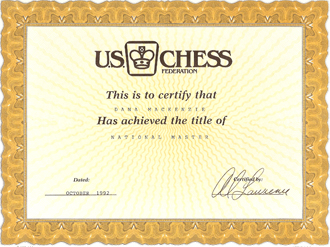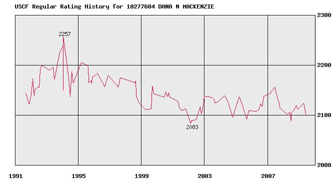Last weekend, as I mentioned in a previous post, I played in the Silicon Valley Challenge, a tournament that offered free entry to National Masters. This posed an interesting question: Would they give me a free entry, even though my current rating is 2102? The minimum rating to become a National Master is, of course, 2200, but I have always heard that once you achieve the title, it’s yours. “Once a master, always a master.”
The TD, Charles Sun, asked me, “Are you a Life Master?” No, I’m not a Life Master — I did not accumulate the requisite 300 games. “Do you have a paper from the USCF that says you are a National Master?” Well, yes I do, but … er, ah, I’ve stashed it away somewhere, probably in my attic, and I don’t know where it is.
Because he’s a nice guy, and maybe because they had enough room, and maybe because it’s easy enough to look up my rating history, he accepted my claim anyway. But this got me wondering: Where the heck has my National Master certificate gone to?
Well, as it turns out, I should have asked my wife, because she knew all along! Kay has a special drawer full of framed things of one sort or another that we don’t have enough wall space for. Sure enough, the certificate was in there. So here it is (belatedly) — proof that I really am a National Master:
I thought some of you might be interested in seeing what one of these looks like.
There is a place in the movie “Searching for Bobby Fischer,” where Bruce Pandolfini (portrayed by Ben Kingsley) motivates Josh Waitzkin by showing him one of these certificates, but if I remember the story correctly it’s actually a bogus certificate — Pandolfini was just using it as a motivational ploy.
In reality, who could be motivated by this? It’s just a piece of paper that someone typed “DANA MACKENZIE” and “NATIONAL MASTER” onto. It’s what that certificate represents that really matters — lots of tournaments, lots of studying, lots of fun times, a lot of bitter disappointments, a few exciting triumphs. Maybe most of all, what it represents is setting a goal and actually accomplishing it.
By the way, here is my rating graph. (Any USCF member can print out a graph of their rating like this at www.uschess.org.)
I find this graph very depressing. It runs from 1991 to the present, and it shows how very brief was the period of time when I was in the Promised Land known as Mastery. An instant in 1992, then a pleasant few months in 1994 when I hit my peak of 2257, and then one more month in 1995. And ever since then, it’s just been on a slow and steady downward trend. If this were a stock, I would not bet on it going back over 2200 again.
That’s why I really like that saying: “Once a master, always a master!”





{ 3 comments… read them below or add one }
What is USCF’s position as to whether you are now a National Master? Is this actually a lifetime title, or is it considered lost when you go below 2200?
I would think that the USCF would no longer consider you to be a NM. I suppose this is probably correct, because otherwise we could apply the same conditions to other “titles.” For example, let’s say a player used to be rated 2099 and his rating dropped to 1800 (the lowest it could drop because of the rating floor). I don’t think we can still call him an expert. Or if a player used to be rated 1999 but his rating dropped to 1700. We surely can’t still call him a Class A player just because he got there once upon a time.
Right now I am trying to get to expert. I have about 30 rating points to go but, if I get there and then later slip below 2000 again, I don’t think I could still be called an expert. It would be nice, though, I admit!
Hi Matt and fan,
I found the answer on Wikipedia! The National Master title is officially a life title. The reference is on Wikipedia (http://en.wikipedia.org/wiki/Chess_master), which states as follows:
In the United States, the title of “National Master” is awarded for life, regardless of whether the rating of a National Master subsequently goes below 2200.[1] In August of 2002, this position was codified (after being recognized as the existing status quo) by the USCF Policy Board with the passage of a motion stating “Any USCF member who has had a regular post tournament rating of 2200 or higher (published or not) has demonstrated a significant level of chess ability and is recognized by being automatically awarded the lifetime title of National Master.”
I think that the reason National Master is different from expert, class A, etc., is precisely because it is a *title*, not a rating level. It’s like a Ph.D., and therefore is not revocable. Expert, on the other hand, is only a rating level; you do not get a certificate from the USCF saying that you are an expert.
This brings up another question, though. When I play in tournaments, is it fair for me to win an under-2200 prize? I have won lots of them. Again, the de facto rule in U.S. chess is that prizes are based on ratings, but it certainly seems a little bit unfair that I can get the benefit of being an NM (free entry to the Silicon Valley Challenge) yet also the benefit of being under 2200. I think the rule should be that you can’t have it both ways *in the same tournament* — if you pay a special NM entry fee, then for prize purposes you should be considered 2200+.
The situation has never arisen previously in my career because I’ve never before played in a tournament that had a special free entry for NMs. In this particular case it was moot because there was no under-2200 prize.
{ 1 trackback }